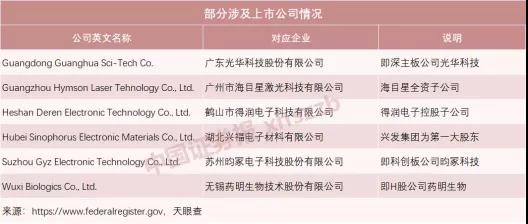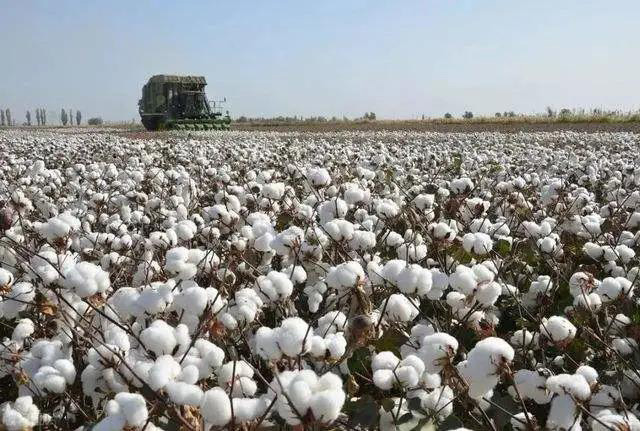Heavy! The United States once again "blocked" 33 Chinese entities. Why did the US cotton industry sway the big stick to China? |
| Time: 2022-02-12 View: 5449 Burst: |
|
On February 7, local time in the United States, 33 Chinese companies in China were included in the so-called "unverified list" by the U.S. Department of Commerce, that is, it is impossible to verify how these entities use goods imported from the United States, in order to restrict these companies from importing controlled products from the United States. products, and requires U.S. companies to be more cautious when dealing with these companies. The Commerce Department's new measures mean that U.S. exporters must be licensed to ship to the Chinese companies on the list, and the Chinese companies must prove they are legal and willing to comply with U.S. regulations in order to continue receiving shipments. The U.S. has previously added a number of Chinese institutions to its so-called "entity list." In December last year, the US added eight Chinese companies to its "investment blacklist" on the grounds of so-called "Xinjiang-related issues". At the beginning of the Year of the Tiger, the United States could not wait to resort to insidious tactics, which shows its intention to suppress China, which makes people worry that Xinjiang cotton will be brought up again by the United States, which will add haze to the textile market this year. The United States once again "blocked" 33 Chinese entities The United States once again unreasonably suppresses Chinese companies On February 7, local time, the U.S. Department of Commerce’s Bureau of Industry and Security (BIS) announced that 33 entities headquartered in China were included in the so-called “Unverified List” (hereinafter referred to as UVL).
Companies on the list must be subject to stricter export controls because U.S. officials cannot routinely check them, the report said. The majority of those included in the UVL list this time are electronics companies, but there are also optics companies, a wind turbine blade company, and university national laboratories and others. China Securities Journal, China Securities Taurus reporters compared and found that in addition to WuXi Biologics, there are many A-share companies involved. In response to the previous "blocking" of a number of Chinese institutions by the United States, the spokesperson of the Ministry of Foreign Affairs has repeatedly stated that China has always opposed the US's generalization of the concept of national security and unreasonable suppression of Chinese enterprises. China will, as always, resolutely defend the legitimate and legitimate rights and interests of Chinese companies. American Cotton: Kill all the people in front of the row, I'm the first! The US crackdown on Chinese institutions is reminiscent of the notion that "China will add Xinjiang cotton to all masks" on YouTube not long ago.
Although there is no evidence that China will do this, it also proves that everyone really regards the so-called "Xinjiang cotton issue" that the United States has hyped up as a focal battlefield in the international struggle. Relying on its dominance in international public opinion, the United States created a big hat of "forced labor" out of thin air to suppress China's Xinjiang cotton industry. At present, there are more than 70 cotton-producing countries in the world, and the three most important cotton-producing countries are China, the United States and India. In terms of production, the largest cotton producing countries in 2020 are China and India, both reaching 29 million bales (480 pounds per bale), followed by the United States and Brazil. China and India are both the largest cotton producers and the two largest consumers of cotton. Among them, China's consumption of cotton accounts for more than 1/3 of the global consumption, so that China cannot meet its domestic consumption with the world's largest output, and needs to be supplemented by imports. According to import statistics, China is the world's largest importer of cotton. China's imports account for more than 1/4 of the world's total, and the top 10 countries in the list of imports are all Asian countries. According to export statistics, in 2020, the United States is the world's largest cotton exporter, with annual exports accounting for more than 75% of its output. Therefore, the lifeline of the US cotton industry exists in the international market, and any major cotton producing country is its actual or potential threat. The United States today spends tens of millions of dollars annually on national cotton industry research. The USDA also launched the "American Cotton Trust Code" project in 2020, which not only formulates the "New American Standard" for cotton planting, but also requires all US-funded enterprises to use the US version of the "Certification System" and "Supply Chain Traceability System". In several years, more than half of the cotton production in the United States has been included in the plan, and the core purpose is to dominate the international rules and order of the cotton spinning industry. It is understandable that the United States vigorously develops its own cotton industry. If it seeks the world's No. 1 throne by its own strength, there is nothing to say, but the logic of American cotton in the international market is: whoever is in the front will kill whoever is in the front, no matter what means are used. Cotton is Brazil's traditional crop and export commodity, and plays a vital role in the national economy. The only cotton trade dispute handled by the WTO came from Brazil, and the defendant was the United States. The reason is that the variety of cotton subsidies that the United States provides to its own cotton, worth $3 billion, is not good for cotton exports from other countries, including Brazil, the world's fifth-largest cotton producer. When it complained in 2002, Brazil asked the WTO to pressure the United States to revise its dumping and compensation measures. American Cotton's butcher knife soon found its next victim - Uzbekistan. In 2010, the United States officially issued a sanction order on Ukrainian cotton and cotton textiles on the grounds of "forced child labor". Until 2019, the United States lifted the ban, but Uzbekistan cotton is still on the "Cotton Movement Blacklist" initiated by the International Cotton Federation. 313 major American brands are still boycotting Uzbekistan cotton. The excuse for refusing to cancel the boycott is still "forced labor." ". The last wave of subsidies and price reductions made Brazilian cotton farmers lose their bottom line and seized a large number of international markets in the US cotton industry. Through this round, they forced Uzbekistan to reduce production and pushed up international cotton prices. The big stick of the US cotton industry's suppression has also been swung to India. The United States used the Monsanto monopoly to keep Indian cotton mired in GMOs and debt, with almost devastating consequences for the Indian cotton industry. From 2008 to 2012, although the proportion of GM cotton planted in India increased from 67% to 92%, the yield per unit decreased gradually. Increased inputs into GM cotton have resulted in a threefold increase in the cost of growing cotton. The United States has used huge and diverse subsidies to its domestic cotton industry to reduce dimensionality and attack Brazilian cotton; and in India, the United States has changed its style and has become the spokesperson of "fair competition in the free market", increasing policy support for cotton to India and the practice of providing cotton subsidies. It can be seen that in the cotton industry, whoever stands in the way of the US's fortune, the US will open the way with a big stick. China's cotton is now seen as America's biggest competitor. The U.S. Department of Agriculture has always paid close attention to China’s strategic cotton reserve policy. The share of Chinese textiles has increased from 10.4% at the beginning of its entry into the WTO to 37% in 2017, which makes the United States believe that China has the ability to change the global textile trade pattern. Therefore, on the issue of "forced labor" to spread rumors about Xinjiang's cotton industry, the US government and even many American and Western companies that have business dealings with Xinjiang's cotton appear on the stage, vowing to start a journey to contain China's cotton industry from all aspects. However, China's cotton industry is not easy to be defeated. The secret method of the United States' previous consecutive battles and victories does not seem to be very effective this time. As Wang Jinhua, vice-chairman of the China National Cotton Industry Association (CCIA), said: "The United States will never be able to dominate the global cotton market all the time." Source: China Securities Journal, Crow School Captain, China Yarn Network, Global Textiles. |






 Language
Language











